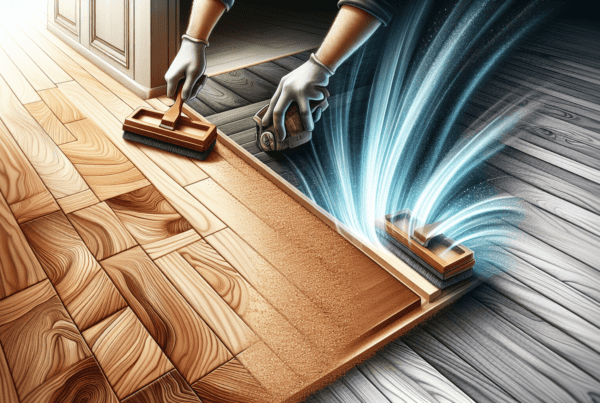In the heart of Wellington, a remarkable team dedicated to the art of timber floor sanding and finishing is making homes shine with heritage and charm. With years of experience under their belt, this group has mastered the intricate process of bringing old, worn-out wooden floors back to life, ensuring each plank tells a story of beauty and resilience. Their services not only preserve the aesthetic appeal of timber floors but also protect them for years to come, making every step within the home a testament to timeless craftsmanship. Join us as we explore how Heritage Timber Floor Sanding & Finishing in Wellington transforms living spaces into picturesque havens of warmth and welcome.
Understanding Heritage Timber Flooring
Definition and Characteristics
Heritage timber flooring encompasses the rich, aged wooden floors that you’ll find in many historic buildings throughout Wellington and beyond. These floors are characterized by their unique patinas, marks of wear and crafting techniques that modern flooring can rarely replicate. Due to the age of the wood, each plank tells a story, contributing to the overall historical narrative of the space.
Historic Significance in Wellington
In Wellington, heritage timber floors are a testament to the city’s past. From grand Victorian homes to storied government buildings, these floors have borne witness to countless footsteps and events. They are not just floors; they’re pieces of history, reminders of the city’s architectural evolution and cultural heritage.
Types of Heritage Timber Floors
Heritage timber floors in Wellington vary widely, from native Rimu and Kauri to imported Jarrah and Oak. Each type has distinct grains, colors, and textures, offering a diversity of aesthetics suited to various architectural styles.
Importance of Maintaining Heritage Timber Floors
Preserving Architectural Integrity
Maintaining these floors is crucial in preserving the architectural integrity of historic buildings. They are intrinsic elements of their designs, reflecting the era and style in which they were built. By preserving them, we’re maintaining an authentic connection to our architectural history.
Increasing Property Value
Well-maintained heritage timber floors can significantly increase a property’s value. Their uniqueness and historical significance make them highly desirable features that attract discerning buyers willing to pay a premium for authentic and timeless beauty.
Sustainability and Eco-Friendliness
In a world increasingly conscious of environmental impact, maintaining and restoring heritage timber floors is a sustainable practice. It reduces the need for new materials, minimizes waste, and preserves the carbon locked within the timber, contributing positively to eco-friendly building practices.
The Process of Timber Floor Sanding
Initial Assessment and Preparation
When we embark on the journey of sanding heritage timber floors, our first step is a thorough initial assessment. This involves evaluating the floor’s condition, identifying repairs, and determining the appropriate sanding technique. Preparation also includes removing furniture, ensuring a clean surface, and setting up dust control measures.
Sanding Techniques for Heritage Floors
Sanding heritage timber floors requires a delicate balance between removing the old finishes and preserving the patina that contributes to the floor’s historical value. We use a combination of coarse, medium, and fine grits to gradually achieve a smooth surface, being mindful to avoid excessive sanding that could damage the aged timber.
Equipment Used in Floor Sanding
In our work, we employ a range of sanding equipment designed to handle different aspects of the sanding process effectively. From belt sanders for the initial heavy sanding to orbital sanders for finishing touches, each tool plays a crucial role in achieving a smooth, even surface ready for finishing.
Finishing Techniques for Timber Floors
Types of Finishes Suitable for Heritage Timber
Selecting the right finish for heritage timber floors is vital in enhancing their beauty while offering protection. We often consider traditional finishes like tung oil or beeswax for their natural look and ability to allow the timber to breathe. Modern polyurethanes are also an option, providing durable protection with a range of gloss levels.
Application Methods
The application of finishes to heritage floors demands meticulous techniques to achieve an even, lasting coat. Whether applying oil with a cloth to penetrate deeply into the wood or using a brush or roller for varnishes and polyurethanes, the method chosen depends on the finish type and the desired aesthetic outcome.
How to Choose the Right Finish
Choosing the right finish for a heritage timber floor involves considering the floor’s usage, the building’s historical context, and maintenance requirements. We often recommend consulting with heritage restoration professionals to make an informed decision that respects the floor’s historical value while meeting contemporary needs.
The Importance of Professional Services
Expertise in Handling Heritage Timber
Professional services bring expertise in handling the unique challenges of heritage timber, from identifying historic wood types to employing restoration techniques that honor the floor’s age. Their specialized knowledge ensures that the restoration process maintains the integrity and beauty of these precious floors.
The benefits of Hiring Professionals
Hiring professionals offers numerous benefits, including quality craftsmanship, efficient project completion, and technical support. Professionals stand behind their work, providing reassurances that DIY efforts cannot match, especially when dealing with the complexities of heritage timber floors.
How to Select a Reputable Service Provider
Selecting a reputable service provider involves researching their experience with heritage floors, reviewing past projects, and assessing their approach to preservation. Recommendations from trusted sources and professional affiliations can also guide us towards providers who will treat our heritage timber floors with the care they deserve.
DIY vs. Professional Floor Sanding and Finishing
Assessing the Scope of Work
Assessing the scope of work is crucial in deciding between DIY and professional services. Simple touch-ups may be within the reach of avid DIYers, but extensive restorations often require the skills, tools, and knowledge of professionals.
Pros and Cons of DIY
DIY projects can offer personal satisfaction and potential cost savings. However, the risks include inadvertent damage to the timber, uneven sanding, or incorrect application of finishes, which can detract from the floor’s value and appearance.
When to Call in the Professionals
We advocate calling in professionals when facing extensive damage, uncertain wood type, or when the floor holds significant historical value. Their expertise becomes invaluable in ensuring the restoration is done respectfully and correctly.
Maintenance Tips for Heritage Timber Floors
Regular Cleaning Practices
Maintaining heritage timber floors involves regular cleaning with gentle, wood-friendly products. Avoid water and harsh chemicals, which can damage the wood. Soft brooms and vacuum cleaners with brush attachments are ideal for keeping floors dust-free and beautiful.
Addressing Wear and Tear
Address wear and tear promptly by applying local touch-ups or reapplying finishes as needed. This proactive approach prevents minor damage from escalating into major issues that require extensive restoration.
Long-term Preservation Techniques
Long-term preservation includes periodic professional inspections, using rugs to protect high-traffic areas, and maintaining a stable indoor climate to prevent the wood from expanding or contracting excessively.
Common Challenges in Sanding and Finishing
Dealing with Uneven Surfaces
Uneven surfaces present a significant challenge in sanding heritage floors. We approach this by using a combination of sanding techniques and tools to gently level the floor without compromising its character.
Restoring Floors with Extensive Damage
Floors with extensive damage require a careful assessment to determine the best restoration approach. Sometimes, individual boards may need replacement with reclaimed timber to preserve the floor’s historical integrity.
Working Around Historical Constraints
Historical constraints often limit the extent of restoration work we can perform. In such cases, our goal is to achieve the best possible outcome within these parameters, preserving the floor’s historical value while ensuring its functionality.
The Role of Technology in Timber Floor Restoration
Advanced Sanding Equipment
Technology plays a crucial role in timber floor restoration, with advanced sanding equipment offering better efficiency and dust control. This ensures a cleaner work environment and a smoother finish, minimizing the impact on the building’s occupants and the floor itself.
Eco-Friendly Finishes and Their Application
Eco-friendly finishes have gained popularity for their lower environmental impact and safety. Modern application methods, including low-VOC formulas and advanced applicators, ensure these finishes are both beautiful and beneficial to indoor air quality.
Innovations in Timber Preservation
Innovations in timber preservation, such as non-toxic treatments and moisture control technologies, offer new ways to protect heritage timber floors from pests, rot, and humidity. These advancements contribute significantly to the floor’s longevity and beauty.
Future Trends in Heritage Timber Floor Restoration
Sustainability in Materials and Practices
The future of heritage timber floor restoration lies in sustainability. We anticipate a continued shift towards using reclaimed materials, environmentally friendly finishes, and techniques that reduce waste and energy consumption.
Emerging Technologies in Floor Restoration
Emerging technologies, such as laser cleaning and 3D scanning for damage assessment, are set to revolutionize how we approach floor restoration. These technologies promise greater precision, efficiency, and preservation of original materials.
Anticipated Changes in Heritage Preservation Standards
We also expect changes in heritage preservation standards to accommodate new materials, practices, and technologies. These changes will likely reflect a balance between preserving historical integrity and embracing sustainable, modern approaches to restoration.
In conclusion, the restoration and maintenance of heritage timber flooring in Wellington is a responsibility we cherish. It’s an art that combines respect for history with the application of modern techniques and materials. By appreciating the value of these floors and committing to their preservation, we contribute to the conservation of our architectural heritage for future generations to marvel at and enjoy.







